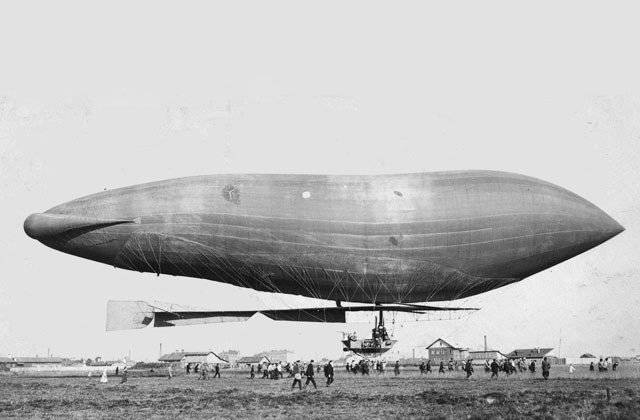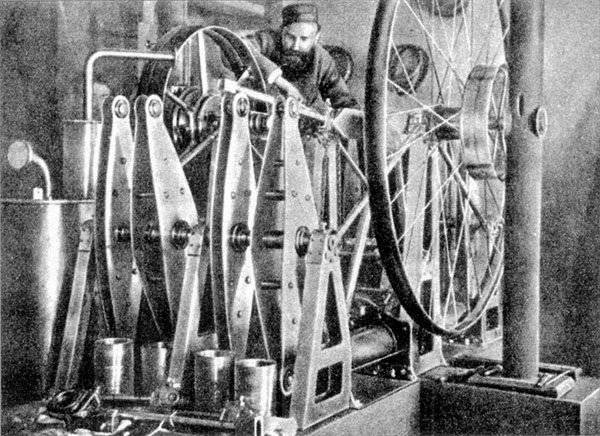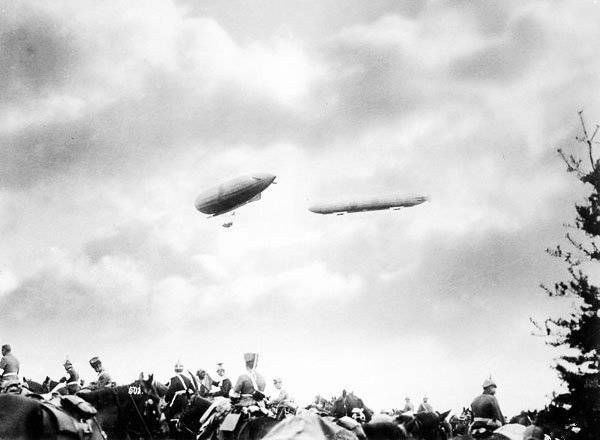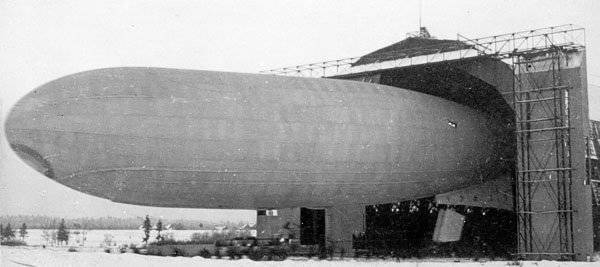Battleships of heaven

Airships of the Great War - as Count Zeppelin overtook "Russia"
If we say that by the beginning of the Great War the sky of Europe belonged to Germany - exaggeration in the military-strategic plan will not be very strong. In 1914 aviation she took only the first steps, and while the short-lived, but the booming ballooning flourished, and the Second Reich had no equal in this area - the silvery silhouettes of German zeppelins reigned almost undividedly in the clouds. Russia, by the way, and other allies in the Entente, had almost nothing to answer. Despite the fact that the Ministry of War had a special commission on aeronautics, pigeon mail and watchtowers, they were skeptical about the construction of airships for a long time. Although they had every chance to become a pioneer and leader in global aeronautics. The project of the airship, almost identical to that which terrified the inhabitants of Europe in 1914, was launched in Russia 20 years before the creation of the first zeppelin. But first, officials decided that its military significance seemed "fortunate", and after the appearance of zeppelins - not relevant.
For the sake of justice, it must be admitted that regarding the role of aviation in a future war, the Russian leadership was not mistaken, and by the beginning of the Great War, Russia had the largest fleet. Due to undeveloped industry and dependence on imports, it’s true that Russian aviation soon fell behind both its allies and its opponents, but that was already completely different. story.
Too early too late
The most advanced technological type of airship in the late nineteenth and early twentieth centuries was the so-called zeppelin — a dirigible rigid scheme, first launched into mass production by the German graph Ferdinand von Zeppelin and his aeronautical company Luftshiffbau Zeppelin GmbH. The main design feature of airships of this type was the presence of a metal (less commonly wooden) frame-truss, fitted with a gas-tight casing, under which the carrier gas was pumped. For their time, zeppelins were genuine air battleships: their length could reach almost 250 meters, and the maximum diameter of the carrying case was more than 40 meters.
Despite the undoubted manufacturability and increased reliability of this type of airships, already at the beginning of the twentieth century they began to “tread on the heels” of the airship of a semi-rigid scheme. It is distinguished by the presence in the lower part of a special “boat-shaped” set of trusses from the trusses, which prevents the “flashing” of a huge bearing body in the rest of the truss. Nowadays, it is the airship of semi-rigid construction, in view of the appearance of new, especially durable materials for a gas-tight hull shell, recognized as the most progressive type.
Russia had all the chances to become one of the first countries that managed to make the airships not only an innovative, but also an industrial phenomenon.
One of the first inventors in the world who proposed to introduce tough and semi-rigid schemes into the production of airships became a subject of the Russian Empire, a Serb by nationality Ogneslav Stepanovich Kostovich. As the author of many truly breakthrough inventions in various branches of technology, Ogneslav Kostovich, 20 years before Ferdinand von Zeppelin, tried to build a large dirigible airship in Russia.

Kostovich's airship, which he symbolically called “Russia”, was to have a record scale for his time - a body with a volume of 5 thousand cubic meters. meters, the length of 64 m and the maximum diameter of 12 m. In the process, the inventor was able not only to formulate, but also bring to the beginning of the industrial cycle two more large-scale technical ideas - the creation of an opposed carburetor internal combustion engine and the production of cemented aviation arborite plywood (canvas, glued from several layers of plywood laid under different directions, due to which it is not subject to warping and cracking). In Russia, none of these ideas — neither the airship, the engine, nor even the arborite plywood — have found military use.
Kostovic's carburetor engine, which has electrical ignition and a technically advanced opposed (at an angle of 180 °) arrangement of the working cylinders, appeared in the 1883 year. A similar engine with in-line cylinders was created in Germany at the end of 1885, in the workshop of engineers Gottlieb Daimler and Wilhelm Maybach. In less than five years, Daimler and Maybach became co-owners of the largest automobile and engine-building concerns. Under the guarantees of Daimler and Maybach, any of the German banks could issue the largest loan.
At the same time in Russia, inventor Kostovich “fought like a fish about ice”, intrusively offering his airship, engine, and even unique plywood to various government departments, including the military. In the end, in order to somehow exist, Kostovich began to produce plywood-arborite barrels for wine and chests - only such products turned out to be in demand. It is curious that at the end of the 30 of the XX century one of the best multipurpose (used as a bomber, fighter-interceptor and reconnaissance aircraft) of the Second World War - the British Mosquito DH98 - was created from aviation plywood, of almost the same composition as arborite.
In Russia, the largest innovative project for the construction of the semi-rigid airship “Russia”, which could have become a true locomotive for the domestic engine-building and aviation technologies with proper state financial participation, has, alas, collapsed.
The construction of the airship began in a semi-handicraft manner at the Okhta Admiralty Shipyard in St. Petersburg in the year 1882. Due to chronic underfunding, the work went slowly; the development of related technologies (engine, aviation materials) was practically not provided. Only seven years later, in 1889, almost all the main parts of the airship were ready for assembly. The aviation boxer engine, simultaneously created by Ogneslav Kostovich, worked steadily, developing the rated power of the 80 l. with. that was more than enough for the calculated power of the airship.
However, the elements intervened at that moment - at the end of 1889, the storm wind from the Gulf of Finland destroyed the assembly shed for the airship. About 55 thousand rubles were required for the restoration - the amount compared to the almost 500 thousand rubles already allocated for the project is almost ridiculous. Kostovich had to once again turn to the military department. The verdict of the commission of the Chief Engineering Department of the War Ministry, adopted at the request of Ogneslav Kostovich, taking into account the money spent, became an example of bureaucratic idiocy: "A giant controlled balloon represents a very fortunate military significance."
As a result, it was decided not to allocate funds for the restoration of the hangar, and the first in the world semi-rigid airship "Russia" was never collected.
After 20 years, in the 1910 year of the “Russia” section, still preserved by the inventor, were still fit for assembly. But for another request of Kostovich, the Ministry of Defense responded differently: “Assembling the airship of the inventor Kostovich is currently inexpedient: both the balloon itself in its idea and the engine for it are of historical interest, since they are far surpassed by balloons used in practice in Europe” .
Of course, that was the case. The production of aeronautical ships, of course, did not stand still in Western countries, while the details of the first Russian airship for decades have been gathering dust at a warehouse in St. Petersburg.
Chasing Zeppelin
The project of the semi-rigid airship Ogneslav Kostovich was, of course, not the only one in Russia. Simply, thanks to his personal charisma, he advanced much further than other projects proposed to the Ministry of War. “Russia” officials were able to ditch only at the exit from the factory shop, they managed to push other design endeavors “on the shelf” even at the “paper stage”.
The military projects did not receive support from the creation of controlled balloon designs D. N. Chernushenko, A. V. Vlazhko, M. I. Malykhina, K. Ya. Danilevsky, I. A. Matyunina, and P. D. Chernova. Successfully managed to “hack” the project of the all-metal airship K. E. Tsiolkovsky, with a report on which he spoke in the 1887 year.
It was only against the background of the impressive success of the Ferdinand von Zeppelin airships that the Russian military department was forced to change its "fortunetelling" position. However, it was already difficult to “catch up”, and even more so “overtake” German aircraft-building technologies.
Von Zeppelin's first airship flew 2 on July 1900. Despite the predictions of infantile "experts" - and in Germany there were also a lot of them - about the deliberate doom of the idea of a controlled aerostat, the launch of the first zeppelin was very successful. All the calculated characteristics were confirmed, moreover, the device convincingly demonstrated good handling. In October, the 1906 of the year successfully flew the third, the 135-meter zeppelin LZ2.
Ferdinand von Zeppelin was greatly assisted by King William Wilhelm II of Württemberg (not to be confused with the Kaiser of the German Empire). The German government has allocated a large tranche for the construction of a new zeppelin building hangar and provided the inventor with state guarantees for bank loans. Germany made a big step forward.

In 1907, the Russian military also “matured”, finally, to a strategic decision in the field of airship construction. The Main Engineering Directorate of the Military Ministry has created a special commission chaired by Lieutenant-General N. L. Kirpicheva to develop the project of a large airship. It included Major General A. M. Kovanko, Colonel E. V. Fedorov, Colonel V. N. Naidenov, famous aerodynamics N. E. Zhukovsky, mathematician and shipbuilder A. N. Krylov and other scientists.
The production of airships started only in 1908 year. The first of the aircraft called "Training" was designed by Captain A. I. Shabsky. It was a primitive small airship of soft construction, repeating de facto the basics of German airship 20-year-old. Flights on it were carried out in the 1909 year. "Training" because of the primitive design did not fly for a long time and the very next year because of the destruction of the shell was disassembled.
At the same time, work was carried out on the creation of the Krechet airship, which in official history is considered to be the first Russian military airship. The design of "Krechet" is designated in special reference books as semi-rigid, but in reality the truss structure at the bottom of the bearing shell of the airship consisted of only a few frames. The volume of the Krechet carrier casing was impressive - 6000 m3, its length was 70 m, and the maximum diameter was 11,4 m. The airship was equipped with two 63 kW engines, fortified in the rear of a small nacelle, hanging on cables under the carrier casing.
"Merry" flew also very short, no more than two years. Its operation, despite the simplicity of the design, was difficult to achieve - the almost complete absence of a Russian school of airship construction in Russia, fraught with the inevitable shortage of specialists, had an effect.
To organize the systematic training of aeronautical engineers for the Russian military department, which had been trampling all the germs of Russian aeronautic thought for 20 years, had to be forced in the same West - in France. In the same place, as the training ships, the airships of the semi-rigid construction “Berkut”, “Swan” and “Kite” were purchased. The airships “Dove”, “Falcon”, “Hawk”, “Kobchik” and “Mixed” were made by Russian forces in the 1910 — 1911 period. All of them were small - no more than 60 m in length, had a weak power supply and a small, no more than 1000 kg payload. The speed of all these airships did not exceed 50 km / h.
Lack of aeronautics
By the beginning of the Great War, the German Empire had not only advanced in all respects airship industry, but also developed military theory on the use of air battleships. The Germans saw three types of tasks for airships in the coming war - operational and strategic (long-range) reconnaissance, long-term adjustment of artillery fire for operational and tactical purposes, and bombardment.
Germany entered the war, having an impressive fleet airships (mostly of rigid construction) of 18 aircraft, 11 of which had a volume of 18–27 thousand m3, cruising speed of 80–90 km / h, flight altitude of 2500–3000 m, and a range of up to 2 thousand km. The payload of zeppelins was 8–11 tons, all of them were armed with 8–16 machine guns, as well as 2–4 small-caliber guns. For their time, these were aircraft of the highest technological level.
During the war years, especially in the initial period, German airships caused considerable damage to military and industrial facilities of the opponents. Already 14 August 1914, the German zeppelin dropped 11 tons of bombs on the Belgian fortress of Antwerp. As a result, at least 900 houses were damaged, and 60 destroyed. There were numerous human victims. At the same time, the night raids of the zeppelins had a tremendous psychological effect both on the troops and on the civilian population, especially in large cities, creating an ominous atmosphere of horror.
15 August 1914 zeppelin bombed Mlawa (East Prussia) station, occupied by Russian troops. “Early in the morning, the zeppelin started throwing bombs, one of which hit the first class hall of the station, pierced the roof and exploded, and another bomb was thrown onto a railroad track, at a landing site of soldiers from one of the trains,” one of the witnesses said. - At the site of the gap were several corpses. Total 10 bombs were dropped.
The Russian Stavka, considering the front-line experience in the use of zeppelin, also decided to turn a few Russian airships into a means of strategic intelligence, albeit rather clumsily. For example, having an obvious shortage of professional aeronautics personnel, the Russian military department unexpectedly disbanded the only battalion of the Officer Aeronautical School in St. Petersburg, sending its personnel to staff the 12, 13 and 14 of the aeronautical companies. As a result, the training system in this specific area was virtually destroyed, which, of course, the problem of lack of personnel only aggravated.
During the war years, companies with controlled aerostats (that is, with low-volume airships) were deployed in Lutsk, Berdichev, Bialystok, Lida, Brest-Litovsk, Kovno, Grodno and other locations. For their maintenance (gas supply and repair) 14 sheds were built. In comparison with Germany, the Russian aeronautical base looked very modest - already at the beginning of the war the Germans had well-equipped air points throughout the country for servicing airships with 39 sheds (of which 53 were superlarge).
In total, during the Great War, the Russian aeronautic units were armed with 14 controlled balloons. This was only part of the aeronautics that the Russian army was supposed to have under the plan for mobilization deployment. But even of these aircrafts, the absolute majority - 10 airships - were outdated, and technically different designs, which complicated their operation in front-line conditions. They rarely flew, were practically not used for long-distance intelligence.
Relatively new, the 1913 units built in the Russian army were only four airships - Condor, Astra, Burevestnik and Albatross. "Condor" and "Astra" were built in France, had a cubic capacity within 9800 m3 and speed of about 60 km / h. The Burevestnik airship was built in Germany and was a well-developed German Perseval PL-14. It had a small volume in 10 thousand m 3 and a speed of about 70 km / h. The Albatros airship was a similar scheme - a version of the Perceval adapted to construction at Russian plants.
Sunset era airships
"Condor", "Astra", "Petrel" and "Albatross" were used in the initial period of the Great War fairly intensively. Especially successful was the combat work of the Condor and Astra, which were in the possession of the 2 aeronautical company in the city of Brest-Litovsk. Having a powerful radio-telegraph station on board, the Condor was used to promptly inform the Supreme Command Headquarters about the movement of the German-Austrian troops.
22 May 1915 of the Year Astra successfully bombarded the railway hub of the city of Lyk. The bombing was carried out at night from a height of 1200 meters, all in all, an 21 bomb was dropped on the enemy (each weighing 16 kg). Having dropped the deadly cargo, the airship immediately “jumped” to the height of 1600 m. This sharp rise was very opportune, since an intensive anti-aircraft fire began from the side of Lyk. Several projectiles exploded dangerously close to the airship, and after landing, several holes were found in its nose. Taking advantage of the dark and fair wind, the Astra quickly left the bombardment area and returned to the base in 5.30.

From the middle of 1915, the combat work of aeronautical companies was greatly complicated by the appearance of fighter aircraft. For nimble fast cars, even the German zeppelin, which possessed considerable firepower, was easy prey - the hydrogen-filled envelope of the airship was easily ignited by incendiary bullets.
Gradually formidable weapons anti-aircraft artillery became against airships. In the daytime, with a flight altitude not exceeding 2000 — 2500 m, there was practically no chance for airships to return safely from a combat mission, especially in the absence of escort fighters.
The first among Russian combat airships at the beginning of 1915, the Condor was killed, probably from the fire of German fighters. At about the same time in March, the Petrel was dismantled. The height of its rise with a combat load did not exceed 1100 meters, which was clearly not enough to successfully escape even from anti-aircraft guns, but from rifle fire. The same fate befell in June 1915, the airship "Astra" - from the set of patched holes the carrier shell finally became useless. Previously, all of his comrades killed the most perfect of them, built at the Izhora plant "Albatross".
This airship was considered the best of all samples of aircrafts created by Russian factories before the beginning of the Great War. It could reach speeds of up to 68 km / h, had powerful engines, an adequate climb ceiling, and most importantly, an aluminized envelope of a carrying balloon that protected the gas from being heated by sunlight and masked the airship well (especially in cloudy weather).
"Albatross" was very unlucky in the fate of the flight. In early September, 1914, he came under the "friendly fire" of the 4 of the Siberian Corps, which had just arrived at the front from Eastern Siberia and was not warned about the possible flight of its airship. The device was successfully landed, and after repairs in Brest-Litovsk it was returned to service. But already on October 13, due to an error in piloting, the Albatross suffered damage incompatible with its further operation.
As a result of the Great Retreat of 1915, the Russian army lost all aeronautical bases and boathouses in Lutsk, Lviv, Brest-Litovsk, in the Kovnenskaya and Grodno fortresses. It was considered inexpedient to create new bases for airships: there was neither a new materiel, nor properly trained specialists to use it competently and expediently. In addition, in 1915, the airships for the Russian army already looked like a kind of weird excess: the army was acutely lacking ammunition, rifles, machine guns, tailing tools and even boots - was it possible to think about airships?
By the middle of 1916, when the Russian army slightly "breathed its breath" in terms of military-technical supply, combat airships were no longer remembered - not only in Russian, but also on the Western European front. The era of high-speed fighters began, and even the mighty German zeppelins gradually shifted from combat missions to execution of courier and diplomatic missions.
Information